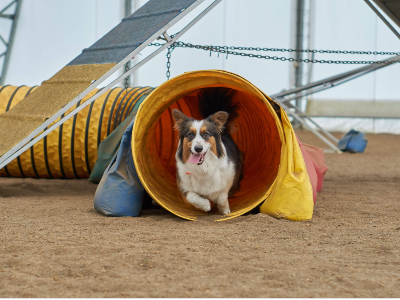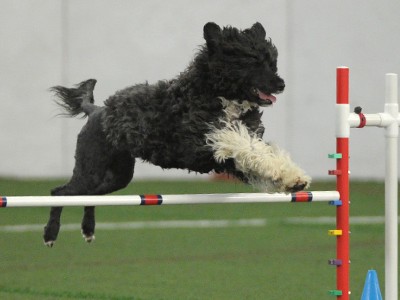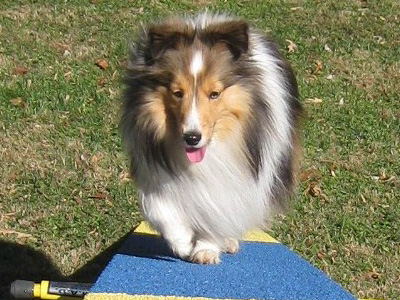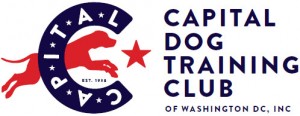-
Agility Classes
Capital teaches AKC Agility classes at all levels, from introductory classes to competition. Our classes, which are generally from 6 to 8 weeks in length, in order of progression are:
Foundations → Introduction → Beginner → Handling A → Handling B → Competition
Capital also teaches skills courses which include: Weaves & Teeters | Distance | Short Sequences
Agility is a rapidly growing sport in which handler and dog race against the clock to navigate an obstacle course. Whether you are looking to compete or just have a great time with your dog, this could be the sport for you! The obstacles used on a course include:
- A-frame
- weave poles
- pause table
- see-saw
- dog walk
- various types of tunnels
- assorted jumps and hurdles
Who can train?
Your dog must be at least one year old for all agility classes, except Foundations and at a minimum, have completed a basic obedience course or equivalent (such as Family Dog). Due to the nature of agility, we allow only one handler per dog, unlike other classes, so please plan accordingly. It is also important that your dog be in good physical condition. Agility is strenuous! Your dog should not be overweight or have any other health problems. Dogs with underlying health problems, including but not limited to hip & elbow dysplasia, cardiovascular disease, vision, or other health problems that limit endurance, balance, or motor control should not participate in agility without consultation with a veterinarian who is familiar with agility. If in doubt, consult your vet and if your dog needs to lose weight, start now! Children under the age of 16 must be accompanied by a parent or legal guardian who will remain in the building throughout the class. Registration for agility classes is contingent upon evaluation and approval by the Assistant Training Director.When are agility classes held?
Capital offers four sessions of agility classes each year: a winter session, a spring session, a summer session, and a fall session. While the schedule varies every session, agility classes are held on either Wednesday or Friday nights and Sundays, throughout the day, into the evening.How do I get started?
If you have never taken an agility class, you will need to start with either Foundations or Introductory Agility. To get a place on the wait-list for introductory agility fill out the Questionnaire below and email the AGILITY PROGRAM . While it varies, the waitlist is currently several months. Spots fill up very quickly, so once you are emailed about an opening, be sure to respond as quickly as you are able. Once your name comes off the waitlist, you will need to pass our “test-in” to make sure your dog has the necessary obedience skills and temperament to succeed in a multi-dog class setting – where some portions take place off-leash. If you have taken agility classes elsewhere, please fill out the Questionnaire below and contact the AGILITY PROGRAM to discuss appropriate class placement.Foundations
Dogs will be introduced to the basic handling and foundation skills needed to be competitive in agility. Foundation training includes clicker training, targeting, fitness training, focus games, rear-end awareness, some introduction to AKC agility equipment, among other things.Introductory
Introduction Agility introduces the dog and handler team to the navigation and use of all AKC agility equipment. The team is also taught the basic skills to confidently and safely complete each obstacle and a series of obstacles on the course.Beginner
This class builds on each of the established foundation skills from the Introduction agility classes and introduces handling elements.Handling
This sequence of several classes—Handling A and Handling B that build on the previously learned handling skills to improve the team and lead towards the ability to compete.Competition
This class provides a forum for competing teams to work on advanced handling skills. Competition Agility is for the advanced student showing their dog in competition.Weaves and Teeter
Teaches confident weaving, with independent entry and the ability to move through 6 weaves and the ability to cross the teeter independently and at height.Distance
For the more advanced agility team, focuses on the ability to handle at a distance, with sends to agility equipment and consistent obstacle focus away from the handler.Short Sequences
Focuses on shorter courses, teaching the ability to break the course down into smaller components to assess the handling options and achieve smoother handling combinations.


-
Contact
For general info: Training SecretaryIntro Agility info: Agility
Location
Capital Dog Training Club
of Washington, DC
2758 Garfield Avenue
Silver Spring, MD 20910
-

Proud Member of
AKC Since 1949 -
Calendar
In case of inclement weather, an email message will be sent to all members via CDTC@Groups.io announcing class cancellations.
Non-members may check the top of this webpage for closure announcements.
